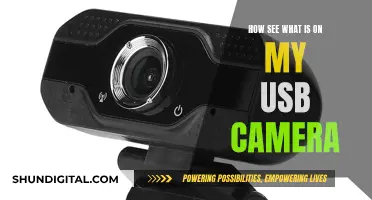
If you want to know what camera was used to take a photo or video, you can check the EXIF data. This can be done by right-clicking on the file and selecting 'properties'. However, it's important to note that not all cameras embed their model in the EXIF data, and video files tend to carry less information than still images. There are also software tools available that can be used to extract this information, such as MediaInfo and ExifTool.
| Characteristics | Values |
|---|---|
| Method | Check the EXIF/XMP metadata |
| Software | MediaInfo, ExifTool, iMediaHUD, Adobe Bridge |
| File Types | CR2, MP4, MOV, AVI, etc. |
What You'll Learn

Check the EXIF/XMP metadata
One way to find out what camera was used to take a photo is to check the EXIF/XMP metadata. EXIF stands for Exchangeable Image File Format, which is a standard for storing supplemental metadata in digital photos. XMP stands for Extensible Metadata Platform and is an ISO standard created and adopted by Adobe Systems Inc.
When you take a picture, your phone or camera usually saves a file (typically a JPEG) to your device's storage. This file contains all the data dedicated to the actual picture (pixels which you can see). It also includes supplemental metadata, such as date, time, camera settings, copyright information, and geolocation coordinates.
To view the EXIF/XMP metadata of an image, you can use a third-party app or the default file manager on your device. On Windows, you can right-click on an image and select "Properties" to view its properties. On a Mac, you can use the Finder app to view basic metadata or the Preview app to view more detailed information.
It's important to note that not all cameras include the camera model in the EXIF/XMP metadata. Additionally, some image formats like GIF don't support EXIF data, and it's possible to remove or edit metadata using various software tools.
Is Your Camera Hacked? Here's How to Find Out
You may want to see also

Use ExifTool
ExifTool is a free and powerful tool that can be used to view the Exif data of image and video files. Exif data is the Exchangeable image file format that contains information about the camera settings used to take a picture or video. This data is embedded in the image or video file itself and can provide details such as exposure time, ISO, focal length, and more.
To use ExifTool to see what camera a file was shot with, follow these steps:
- Download the ExifTool software from the official website (https://exiftool.org/). There are versions available for both Windows and Mac OS X.
- Extract the downloaded executable file to a folder on your computer. For Windows, you can create a new folder specifically for ExifTool (e.g., C:\programs\exiftool\\).
- If you are using the Windows version, you will see two files: exiftool(-k).exe and exiftoolgui.exe. Rename the exiftool(-k).exe file to exiftool.exe by removing the (-k) from the filename.
- Create a shortcut to the exiftoolgui.exe file, which will serve as the graphical user interface (GUI) for ExifTool.
- Launch the exiftoolgui.exe file. This will open the ExifTool GUI, providing a user-friendly interface to interact with the ExifTool command-line tool.
- Use the ExifTool GUI to browse and select the image or video file for which you want to view the Exif data.
- ExifTool will display the extracted Exif data, which may include information about the camera make and model, as well as other camera settings.
It is important to note that not all cameras include the camera model information in the Exif data. Additionally, if the file has been edited or processed extensively, some Exif data may be lost or modified. Therefore, it is recommended to check the original, unedited file straight out of the camera for the most comprehensive Exif data.
The Evolution of Broadcast TV Cameras: Why So Large?
You may want to see also

Try iMediaHUD
If you're looking to find out what camera a file was shot with, you can try iMediaHUD, a free multimedia inspector that uses Mediainfo to give extended information about video and audio media files. Here's how you can use iMediaHUD to find out what camera a file was shot with:
IMediaHUD is a free and user-friendly tool that allows you to inspect multimedia files and extract information about them. It is compatible with macOS and can be easily downloaded online. Once you have iMediaHUD installed on your Mac, follow these steps:
- Open the iMediaHUD application: Locate the iMediaHUD application on your Mac and double-click to open it. The iMediaHUD window will appear, providing a simple and intuitive interface.
- Drag and drop your media files: iMediaHUD supports both media files and folders containing media files. Simply drag and drop the files or folders into the main window of iMediaHUD. You can open multiple info windows for easy comparison between files.
- Access extended information: With your files added, iMediaHUD will automatically start analyzing them and presenting extended information. This information includes details about the camera used to capture the media, such as the camera model and other relevant specifications.
- Explore additional features: iMediaHUD provides a range of additional features to enhance your multimedia inspection experience. For example, you can open multiple info windows to easily compare different files and view their metadata side by side.
By using iMediaHUD, you can quickly and conveniently determine what camera was used to capture a particular photo or video. This can be especially useful if you have a large collection of media files and want to organize them based on the camera they were shot with. Additionally, iMediaHUD offers a straightforward and user-friendly approach to inspecting your multimedia files, making it accessible to both beginners and advanced users.
Roku TV: Camera-Equipped or Not?
You may want to see also

Use Adobe Bridge
Adobe Bridge is a powerful tool for managing and editing images, including those captured in your camera's raw file format. It is a companion program for Photoshop and other apps in the Adobe Creative Cloud.
Adobe Bridge allows you to preview and manage files, including images captured with your camera. Here's how you can use Adobe Bridge to view what camera a file was shot with:
- Launch Adobe Bridge: Open Adobe Bridge from Photoshop by going to the File menu and choosing "Browse in Bridge". Alternatively, on a Windows PC, you can launch it from the Start menu, and on a Mac, it is found in the Applications folder.
- Launch the Photo Downloader: With Bridge open, launch the Photo Downloader app. This is done by going to the File menu and choosing "Get Photos from Camera". You can also launch the Photo Downloader by clicking the camera icon in the toolbar.
- Choose Your Camera or Memory Card: Use the "Get Photos from" option to select the source of your images, which can be your camera or memory card. If your device is not listed, ensure it is properly connected to your computer, and then click the "Refresh List" option.
- Switch to the Advanced Dialog: The Advanced Dialog provides more options and a larger preview area with thumbnails of all the images on your camera or memory card. To switch to it, click the "Advanced Dialog" button in the lower-left corner of the dialog box.
- Select the Images You Want: In the preview area, you can choose which photos you want to download. By default, all images are selected, but you can uncheck the ones you don't need. If there are many images to exclude, you can uncheck all and then manually select the ones you want by holding the Ctrl (Win) or Command (Mac) key and clicking on the desired images.
- Choose Where to Save the Images: Specify the location on your computer where you want to save the images by clicking the "Choose" button in the "Save Options" section.
- Create a Subfolder for the Images (Optional): To keep your photos organised, you can create a subfolder within the location you specified. By default, the subfolder will be named based on the date the photos were taken, but you can also choose "Custom Name" and enter your desired name.
- Rename the Files (Optional): The Photo Downloader allows you to rename your images as they are being downloaded. However, it is generally recommended to review and delete unnecessary images first and then use the Batch Rename feature in Adobe Bridge to rename multiple files at once.
- Add Your Copyright Information (Optional): In the Advanced Dialog, you can add creator and copyright information to your images as they are being downloaded.
- Download Your Images: Once you have made your selections and configured the settings, click the "Get Media" button to start downloading your images.
Additional Tips:
- You can launch the Photo Downloader automatically when you connect your camera or memory card to your computer. However, this option is currently only available on Mac.
- Adobe Bridge allows you to copy and paste Camera Raw settings from one image to another, which is useful when you have multiple similar photos that require the same edits.
- You can adjust a setting in the Preferences to enable editing Camera Raw settings directly within Adobe Bridge instead of opening them in Photoshop. Go to Preferences (Edit menu on Windows, Adobe Bridge menu on Mac), click on "General", and select "Double-Click Edits Camera Raw Settings in Bridge".
MacBook Camera Range: How Far Can It See?
You may want to see also

Check the properties
If you want to find out what camera was used to shoot a photo or video, you can check the file's EXIF/XMP metadata. On a Windows device, you can do this by right-clicking on the file and selecting 'Properties'.
However, it's important to note that not all cameras embed the model information in the EXIF data. Additionally, video files tend to carry less information than still images. Older professional formats (tape) and more consumer-oriented digital formats (MP4, AVCHD) don't typically include a lot of metadata. Newer professional formats are more likely to store extensive metadata, often in sidecar files. For example, the Arri Alexa stores its metadata in ALE and XML files, while Sony XDCAM and XAVC systems provide a wealth of information, including the serial number and firmware version of the lens.
There are several tools available to help you extract EXIF data from files. For Windows users, iMediaHUD provides a range of information, including codec, colour space, and chroma subsampling, but it doesn't always show the camera type. MediaInfo is another free tool that can read and interpret EXIF data for videos. ExifTool is a command-line application that can also extract EXIF data from video files. It has a graphical user interface, making it easier to use.
While it's possible to identify the camera model used in some cases, it's not a consistent or foolproof method. The availability and depth of metadata depend on various factors, including the camera model, the recording format, and how the files have been handled and transferred.
Apple's Watchful Eye: Camera Surveillance Concerns
You may want to see also
Frequently asked questions
You can use a metadata viewer such as MediaInfo or ExifTool to find out the camera model used to shoot a video. However, not all cameras include this information in the metadata, and it may be missing if the video has been edited or converted.
You can view the EXIF/XMP metadata of the image file to find out the camera model. On Windows, you can do this by right-clicking on the file and selecting "Properties".
If you only have access to a composite image or a printout of a photo, it may be difficult or impossible to determine the camera model used. This is because the image could be made up of images from different cameras, or the printing process may have removed metadata.







